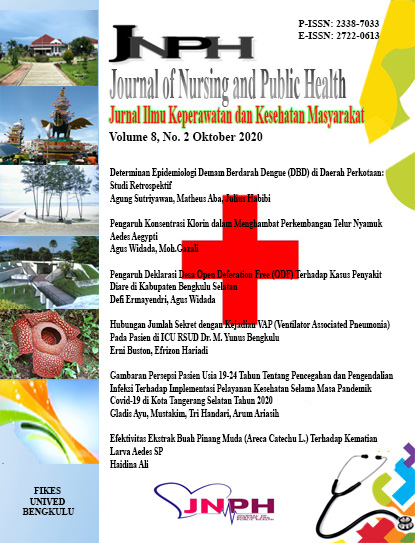DETERMINAN EPIDEMIOLOGI DEMAM BERDARAH DENGUE (DBD) DI DAERAH PERKOTAAN: STUDI RETROSPEKTIF
Abstract
Penyakit Demam Berdarah Dengue (DBD) di Indonesia masih menjadi masalah kesehatan masyarakat. Nyamuk Aedes aegypti sebagai vektor utama DBD memiliki pola hidup di daerah panas sehingga penyakit ini berkembang di perkotaan daripada di perdesaan. Tujuan penelitian ini untuk mengetahui hubungan determinan epidemiologi dan kejadian DBD. Ini adalah studi kasus-kontrol. Jumlah sampel sebanyak 434 responden. Sampel kontrol diambil berdasarkan beberapa kriteria: 1) usia responden maksimal 5 tahun dari usia kelompok kasus, sampel kontrol yang dipilih adalah tetangga kelompok kasus. Data diperoleh berdasarkan hasil observasi dan penyebaran kuesioner kepada responden. Faktor risiko dianalisis menggunakan uji chi-square, untuk menentukan besarnya risiko menggunakan Odds ratio (OR). Setelah itu, analisis multivariat dilakukan dengan menggunakan regresi logistik ganda. Variabel yang berhubungan dengan kejadian DBD adalah sikap (0,000), 2,9 (1,7-4,8), pemberantasan sarang nyamuk (0,001), 2,3 (1,4-3,8), penggunaan obat nyamuk (0,004), 2,0 (1,2-3,2), penggunaan kelambu (0,000), 2,7 (1,7-4,5), jentik nyamuk (0,000), 4,1 (2,5-6,7) , kepadatan hunian (0,043), 1,6 (1,0-2,6), pemantauan jentik berkala (0,006), 1,9 (1,2-3,1), fogging (0,001), 2,2 (1,3-3,7), larvasida (0,000), 2,5 (1,5-4,1), dan pendidikan DBD (0,000), 4,0 (2,4-6,6). Determinan epidemiologi yang paling dominan dari kejadian DBD adalah jentik nyamuk. Orang yang tinggal dirumah yang terdapat jentik nyamuk memiliki peluang 4,1 kali lipat untuk terjangkit DBD.
Downloads
References

An author who publishes in the Journal of Nursing and Public Health agrees to the following terms:
Author retains the copyright and grants the journal the right of first publication of the work simultaneously licensed under the Creative Commons Attribution-ShareAlike 4.0 License that allows others to share the work with an acknowledgement of the work's authorship and initial publication in this journal
Submission of a manuscript implies that the submitted work has not been published before (except as part of a thesis or report, or abstract); that it is not under consideration for publication elsewhere; that its publication has been approved by all co-authors. If and when the manuscript is accepted for publication, the author(s) still hold the copyright and retain publishing rights without restrictions. For the new invention, authors are suggested to manage its patent before published. The license type is CC-BY-SA 4.0.
Journal of Nursing and Public Health is licensed under a Creative Commons Attribution-ShareAlike 4.0 International License.
You are free to:
Share — copy and redistribute the material in any medium or format
Adapt — remix, transform, and build upon the material
for any purpose, even commercially.
The licensor cannot revoke these freedoms as long as you follow the license terms.









